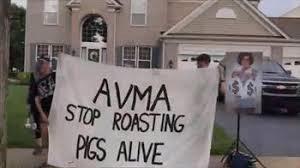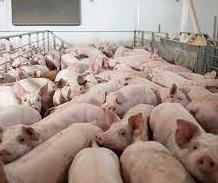 The COVID outbreak disrupted operations of red meat plants during the first quarter of 2020, extending through May with an effective reduction in plant capacity of over 50 percent due to absenteeism among line workers. This resulted in temporary closure of 38 Midwest plants and with reduced throughput after resuming operations. The hog industry was especially impacted with farms unable to consign market-ready animals to slaughter. As a consequence, hog producers resorted to mass euthanasia. Ventilation shutdown with supplementary temperature and humidity was evaluated and documented in a recent peer-reviewed article1. A field trial of ventilation shut-down (VSD) demonstrated that the duration required to achieve death in a herd could be interpreted by a reasonable consumer to represent “extreme suffering”. The American Veterinary Medical Association Guidelines for Depopulation of Animals requires any method of mass-euthanasia such as VSD to achieve 95 percent mortality of a flock or herd within an hour. This is a questionable and somewhat self-serving standard inconsistent with public perceptions of welfare-ethics and humanity.
The COVID outbreak disrupted operations of red meat plants during the first quarter of 2020, extending through May with an effective reduction in plant capacity of over 50 percent due to absenteeism among line workers. This resulted in temporary closure of 38 Midwest plants and with reduced throughput after resuming operations. The hog industry was especially impacted with farms unable to consign market-ready animals to slaughter. As a consequence, hog producers resorted to mass euthanasia. Ventilation shutdown with supplementary temperature and humidity was evaluated and documented in a recent peer-reviewed article1. A field trial of ventilation shut-down (VSD) demonstrated that the duration required to achieve death in a herd could be interpreted by a reasonable consumer to represent “extreme suffering”. The American Veterinary Medical Association Guidelines for Depopulation of Animals requires any method of mass-euthanasia such as VSD to achieve 95 percent mortality of a flock or herd within an hour. This is a questionable and somewhat self-serving standard inconsistent with public perceptions of welfare-ethics and humanity.
The authors of the article cannot be criticized in either their attempt to achieve rapid euthanasia under extreme conditions nor with their forthright publication of the documented field trial. The article elicited two contributions in the form of letters to the Editor indicating that VSD was morally unacceptable especially for hogs whether at the nursery or finishing stage together with a response from the authors.
Trials using mature hens were conducted at North Carolina State University in a chamber to determine the physiological effect of various combinations of carbon dioxide, temperature and duration simulating VSD. This work was motivated by the need to euthanize flocks of caged hens during the 2015 highly pathogenic avian influenza epornitic. Anecdotal reports of high mortality in caged hens resulting from accidental power failure or extreme heat suggests that caged flocks are susceptible to hyperthermia with some episodes resulting in up to 70 percent mortality within 90 minutes.
 Despite studies on combinations of heat, temperature and carbon dioxide under experimental or small-scale conditions there is no effective, practical or morally acceptable method of mass euthanasia for caged laying flocks. A similar situation would apply to aviary systems irrespective of whether flocks are allowed floor access or are confirmed to modules. The use of carbon dioxide foam is effective and humane in floor housed broiler and turkey flocks. For slat and litter housing producing cage-free eggs it will be necessary to herd and confine hens to the litter area.
Despite studies on combinations of heat, temperature and carbon dioxide under experimental or small-scale conditions there is no effective, practical or morally acceptable method of mass euthanasia for caged laying flocks. A similar situation would apply to aviary systems irrespective of whether flocks are allowed floor access or are confirmed to modules. The use of carbon dioxide foam is effective and humane in floor housed broiler and turkey flocks. For slat and litter housing producing cage-free eggs it will be necessary to herd and confine hens to the litter area.
Protests over mass euthanasia required to control highly pathogenic avian influenza in 2015 were relatively muted. It is predicted that in the event of a future outbreak, there will be considerable opposition to VSD for chicken flocks. Recognizing the practical problems of VSD and its relatively inhumane consequences, USPOULTRY has called for proposals to achieve mass euthanasia that would presumably be more acceptable to consumers and regulators. Anecdotal reports suggest that toxic compounds including organophosphates have been added to drinking water to dispose of flocks rapidly and with less stress than would be induced by VSD. Until a suitable compound can be identified, the industry and those responsible for control of catastrophic diseases will be obliged use manual labor and kill-carts or alternatively some mechanized version of hypercapnic euthanasia. Prototype mobile equipment has been demonstrated but application still requires transfer of hens from cages to a receiving hopper.
The application of VSD is fraught with public relations implications. Not only will individual companies be subjected to extensive criticism in this age of the internet and 24-hour news cycle, degradation of brand value and consumer rejection of table eggs will be inevitable. These consequences will have even greater long-term financial impact than that caused by the disease for which Federal compensation is anticipated.
1.Baysinger, A. et al. (2021). A case study of ventilation shutdown with the addition of high temperature and humidity for depopulation of pigs. J. Am Vet Med Assoc. 259: 415-424